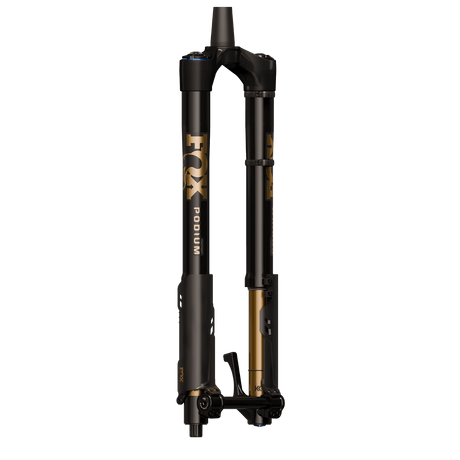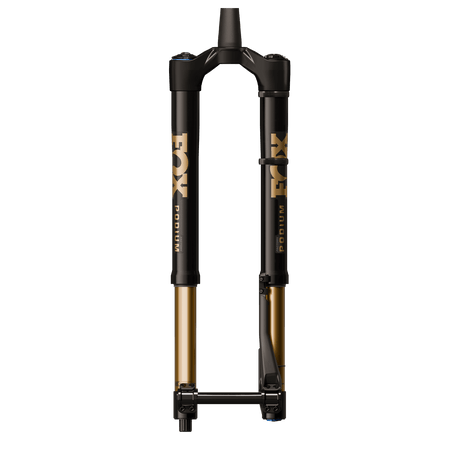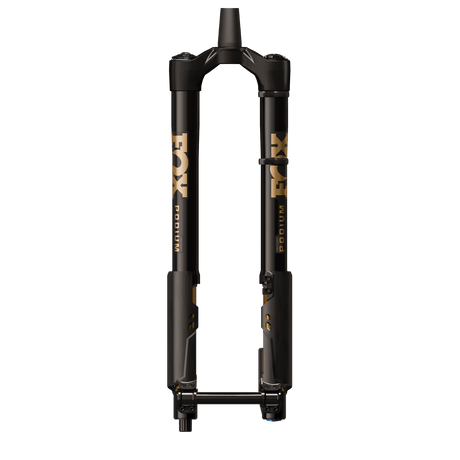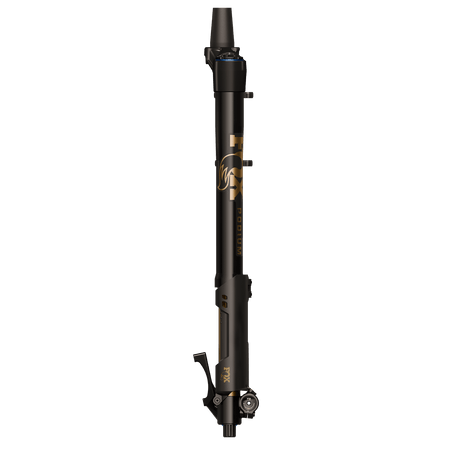Fox just flipped the suspension world upside down, literally. Meet the new Podium: an inverted, single crown fork built specifically for enduro racing. I’ve been riding this thing for the past month, and today we’re diving into whether this exotic-looking fork actually delivers on Fox’s bold claims of increased grip, stiffness, and control, or if it's just a flexy noodle covered in Kashima. In this video, we’re gonna cover why the heck Fox made an inverted fork, look at all the tech inside and out, and of course, talk about how it performs out on the trail.
WATCH the Video:
We first got to see the Podium earlier this year at the Fox office in Scottsdale. Fox gave us a deep dive on the Podium with tech presentations, pro rider interviews, the whole nine yards. Unsurprisingly, everyone from Fox only had good things to say about this fork, claiming that it’s the highest performance fork they’ve ever made. Apparently, it was so good that none of the pro riders wanted to give back the prototypes they got to test. Of course, I was pretty skeptical, because upside-right forks already offer some pretty darn amazing performance, so why bother reinventing the fork? Turns out, there are some pretty good reasons.
Fox Podium
- Inverted design
- 150, 160, or 170mm of travel
- 29" Only
- 36mm stanchions
- 47mm upper tubes
- GRIP X2 Damper (HSC, LSC, HSR, LSR)
- Glidecore NA3 Air Spring
- 20x110mm Boost hub spacing
- Factory Series only
- $1999
- 2695g
In between the tape, where the Podium was built to be
Upside-down forks explanation
Let’s cover the basics of an upside-down or inverted fork, and explain why Fox would even go down this road in the first place. Upside-down forks come in all sorts of shapes and sizes. Single crowns, dual crowns, and that one fork from Intend that's somewhere in between. There are three main advantages that are inherent to any well-executed upside-down fork, such as the Fox Podium, Push Nine One, Manitou Dorado, or Fox 38, that is mid backflip. There are also some disadvantages, which we’ll cover in just a second.
The first advantage is that all of the bath oil in an inverted fork is sitting right on top of your seals, keeping your stanchions more lubricated compared to an upside right fork. Your stanchions pass through a column of oil every time your fork compresses, instead of relying on foam rings and oil splashing up from the bottom to keep the fork lubricated. This makes for a very slippery system.
Another advantage of an upside down fork is the lower unsprung mass at your front axle. Instead of those heavy lowers moving back and forth, the lightweight stanchions are getting out of the way of rocks and roots, directly translating to more suppleness, and straight up more traction.
Last is what Fox claims makes the biggest difference compared to a normal fork, and that is the increased fore-aft stiffness that comes from the upside-down design. With oversized tubes at the top of the fork, there’s an incredibly solid connection between the fork tubes and the crown of the fork. That allows inverted forks to maintain their shape and flex less when running straight into obstacles out on the trail.
As for disadvantages, upside-down forks have a reputation of being very flexy. Without that arch between the legs, it’s easy to imagine how an inverted fork could get all bent out of shape in a corner or when it deflects off a rock. To fight that flex, manufacturers add material in some very strategic areas to fight that flex, which results in a heavier fork. That’s why we don’t typically see inverted forks on cross-country bikes, and they’re pretty much only used in gravity applications, where riders are willing to add some weight to get more performance. Plenty of riders choose heavier components like downhill tires, coil shocks, and big brakes to increase their bike’s performance, so what’s stopping them from choosing a heavy, yet high-performance fork?
Riding the Podium
I have to say that I was more excited to ride the Fox Podium than any other new bike part I’ve tried recently. Upside down forks have always had that exotic allure to them, and until now, I’ve never gotten the chance to ride one. Our head mechanic Alex got the Podium installed on my Sentinel, and we’ve got the 170mm air spring in there. I started with Fox’s recommended settings, but ended up changing things quite a bit through some bracketing to get to a comfy and fast setup. I went up in air pressure, about 5 psi more than Fox recommends for my weight, went up to 5 volume spacers from the stock 2, almost completely closed the compression, and added a little bit of rebound damping. Adjusting the air spring and damper is exactly the same as any other fork, and I didn’t change my setup techniques at all for the Podium.
Once I made those changes, the Fox Podium became the best performing single crown fork I’ve ever ridden. It’s hard to pinpoint exactly where the performance comes from, and it’s almost like riding a coil shock for the first time if you’ve only ever ridden air shocks. With less friction in the whole system, the Podium is able to consistently give me more grip and confidence in my front wheel than any other enduro fork I’ve ridden. This upside down fork has a way of finding traction in ways I’ve never gotten out of a 38 or a Zeb, especially in loose, high speed corners where I’m really depending on my front tire to hold its line and the Podium is able to give me that grip more often. It’s got a slightly softer and more compliant feel in those scenarios, and almost feels like it’s conforming to the shape of the corner, giving me less feedback to the hands and overall, slightly more comfort. I know lots of people have a notion of inverted forks being twisty and lacking that torsional stiffness, but I think that slight twist is exactly what’s giving me that comfort and grip in the corners. It never felt like the chassis twisted so much that I lost control, and it was always a comfortable and controlled slight contortion that helped the front tire hold its line in a corner more consistently.
In a straight line through rough sections of trail, the Podium is without a doubt, the stiffest single crown fork I’ve ridden, but it manages to feel stiff without feeling harsh. Those huge upper tubes give the Podium such a stout chassis that it almost feels like a dual crown downhill fork the way it’s able to charge through deep holes that would have any other single crown flexing and twisting. I think that’s one of the reasons why motos use inverted forks, and if they’re stiff enough for those 200 plus pound bikes to get smashed into ruts and whoops, then they’re certainly stiff enough for our little mountain bikes. Even though it’s stiffer than a 38 in those straight line scenarios, it’s still more comfortable, and it doesn’t feel like you’re fighting the chassis at all. I’m able to focus more on my riding, and less about what the fork is doing. I’ve said this before about other products, but that’s the number one thing I’m looking for in any mountain bike product. If a component lets me think about my bike less, then I’m sold. That frees up more mental space to focus on hitting a crazy line or set up for a tricky corner.
The Podium reminds me of a coil shock in the way it’s able to find traction and move so freely, but then it still has that support and ramp-up deep in the travel you expect from an air shock, once you put some volume spacers in it. I definitely used all of my travel more than I wanted with the stock 2 volume spacers in there, and the Podium has a quite linear air spring. Considering that this fork is designed for the highest level of enduro racing, I expect most riders to be stuffing some more volume spacers in there. Or, if you want a pseudo coil like experience, you can take all of those volume spacers out and get a very linear fork!
Fox calls the Grip X2 their ultimate descent focused damper, so of course it’s found its way into the damper side of the Podium. I’ve really enjoyed my time on this same damper in the 36 and the 38, and have gotten it set up almost perfectly in the Podium. After starting with the recommended compression settings, I’ve been adding compression until I’ve gotten to the point of being closed in low speed and almost closed in high speed compression. If I was to keep riding this fork long term, I think I would opt for a stiffer compression tune during my first damper service to get me back towards the middle of my compression range. Fox says that the Podium’s Grip X2 is tuned specifically for more compression support compared to the 36 and 38, but I’m about in the middle of the compression range of those two forks, and don’t feel I would benefit from a different tune in those forks. It could be that I’m riding this fork harder than I am those other two Fox forks, and that’s why I’m wanting more compression, but regardless, I think that for me, there’s even more performance on the table for the Podium with a stiffer compression tune. That's just me, though, and someone like Mike behind the camera who prefers very soft compression in their fork would likely be very pleased with the way it feels as-is. If you do buy this fork, just ride the damper in its stock form before getting custom with it.
Claimed weight of Fox Forks
40 Grip X2: 2745g (6.05 lbs)
Podium Grip X2: 2695g (5.94 lbs)
38 Grip X2: 2314g (5.10 lbs)
36 Grip X2: 2130g (4.69 lbs)
36 Grip X: 2010g (4.43 lbs)
The last thing I’ll touch on is the weight of the Podium, and this fork is very heavy. I want to highlight that the Podium is only 50 grams lighter than the dual crown 40. That’s right, the dual crown, 200 mil travel downhill fork is only 50 grams heavier than this 170mm single crown enduro fork. Honestly, if Fox made a 170mm air spring for the 40, putting that on the enduro bike might be the right call. You’d definitely win the head game at the top of the enduro race if you pulled up with a full on downhill fork.
While climbing with the podium, I can definitely notice the heavy front end of the bike. When you’re popping the front up and over a rock or a root, that’s when I notice the weight the most, but if you’re just grinding up a long fire road, I can’t say I notice the weight at all. On the way down, the Podium feels much lighter than the numbers would suggest, and it doesn’t feel any heavier than a normal fork when you’re just riding general trail. All that extra weight is sprung mass, and while it’ll change the center of gravity of your bike a bit, the added weight won’t drastically impact the overall handling of the bike. If you’re looking to jump and jib off everything in sight, this might not be the fork for you, and I did notice the weight when pulling for gaps or manuals.
Feels best when pinned. As demonstrated here.
Should you buy?
It’s no secret that the Fox Podium isn’t for everyone. There are tons of riders out there that are stoked on their current upside right fork, and those forks aren’t going anywhere anytime soon. I’ve mentioned the price a few times now, and the Fox Podium costs two thousand dollars. With that said, this definitely doesn’t fall in the budget category. This is a fork that costs top dollar, but you get top performance in return. If you’re ok with the price, the weight, and finding a new hub, then I really don’t think there’s a better fork than the Fox Podium on the market right now. You will hands down get more traction and more descending confidence in all trail conditions with this inverted fork than anything else I’ve ridden. For anyone racing enduro and looking for an advantage, you will get an advantage with this fork compared to a normal, upside right, 38 mil stanchion enduro fork.
While the podium was specifically designed for racers, you don’t have to be a racer to enjoy this fork. I imagine the Podium will end up on the front of a lot of dream builds, especially ebikes, where the added weight is just another drop in the bucket. We’re going to put our Podium on the shop ebike for the long haul, and I bet that there will be lots of ebikers out there that are stoked to get their hands on the new Fox Podium.
No matter whether you’re in the market for the Podium or not, It’s exciting to see Fox shake things up, and I can’t wait to see if other big companies like RockShox or Ohlins come out with inverted forks of their own. With how proven the inverted architecture is on motorcycles, it’s exciting to see if upside down fork technology can get lighter or more affordable down the line so more riders are interested in trying it out for themselves.





